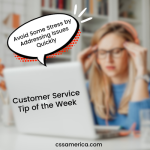 Twitter. When you hear that word, does your temperature rise? Do you roll your eyes? Do you ask: What is Twitter?
Twitter. When you hear that word, does your temperature rise? Do you roll your eyes? Do you ask: What is Twitter?
From a customer service perspective, Twitter has evolved into a virtual place for consumers to complain about businesses. For those businesses savvy enough to understand the importance of communicating with customers in customers’ preferred communication vehicle, Twitter can be an effective and needed place for service recovery to occur.
Bad Incident, Good Service
For this Tip of the Week, Twitter was a source of a tip. A writer shared a personal story about his recent travel. He called the airline in question by name. But the Tweet was positive. He said he had a stroller damaged on a trip. He noted that the airline handled the “situation promptly and fairly,” and it “never turned into a fight. Just fixed it. Appreciate the customer service.”
This issue was apparently caused by the airline, and luckily they were dealing with a reasonable customer. This was a customer who had engaged businesses before where one of those company’s issues was made worse by how the company responded. Companies can often get defensive. They can argue insignificant points about the situation or try to deflect blame from themselves instead of focusing on empathy for the customer and the solution to the situation.
This customer actually appreciated the customer service, but they also highlighted their appreciation for the company not turning a company-caused issue into a fight with a customer.
A Different Definition of “Good Customer Service”
Yes, customer service in today’s world is such that good customer service is often defined as companies just not making their initial mistake worse by how they address the issue.
When dealing with a customer who’s complaining about a mistake your organization made, you’re in a delicate position. Be a little extra in-tune with that fact so that what you say and how you say it is not something that makes the situation worse. Offer the empathy, find a path to a solution, and avoid the defensiveness and arguments that can lead to the fight.
Avoid making a bad situation worse.
Signup for FREE Tips! Contact Us More Resources for You Visit Our Home Page























